Bibliometric Analysis and Review of Global Academic Research on Drug Take-Back Programs
Abstract
1. Introduction
2. Methods
2.1. Data Sources and Search Strategy
2.2. Analysis Tools
3. Results
3.1. Publication and Citation Trends
3.2. Country Performance
3.3. Institution Performance
3.4. Author Performance
3.5. Distribution of Journals and Disciplines
3.6. Cited References
3.7. Analysis of Author Keywords
4. Discussion
4.1. General Information
4.2. Main Research Themes
4.2.1. Assessment of KAP Levels Associated with Drug Take-Back and Their Influential Factors
4.2.2. Treatment of Medications Collected in Drug Take-Back Programs
Deactivation Systems for Returned Medications
Medicines Reuse and Reverse Logistics Systems
4.2.3. Evaluation of Drug Take-Back Intervention Activities
4.2.4. Analysis of Regulations and Policies Regarding Medication Waste Management
4.2.5. Role of Drug Take-Back Programs in Mitigating Environmental and Public Health Hazards from Medicine Waste
4.3. Future Prospects
4.4. Limitations
5. Conclusions
Supplementary Materials
Author Contributions
Funding
Institutional Review Board Statement
Informed Consent Statement
Data Availability Statement
Conflicts of Interest
References
- Kaya, A.; Genç, F. Rational drug use and the disposal cost of unused medications within house; a descriptive-cross-sectional study. BMC Public Health 2025, 25, 622. [Google Scholar] [CrossRef]
- Yimer, A.; Moges, G.; Kahissay, M.H. Household storage and disposal of unused and expired medicines in Dessie, Ethiopia: A cross-sectional study. Front. Public Health 2024, 12, 1422304. [Google Scholar] [CrossRef]
- Barenie, R.E.; Leav, K.; Edward Johnson, W.T., 3rd; Wheeler, J.S. Review and assessment of drug disposal state statutes in the United States, 2022. J. Am. Pharm. Assoc. 2022, 62, 1865–1869. [Google Scholar] [CrossRef] [PubMed]
- Kelly, F.; McMillan, S.; Spinks, J.; Bettington, E.; Wheeler, A.J. ‘You don’t throw these things out’: An exploration of medicines retention and disposal practices in Australian homes. BMC Public Health 2018, 18, 1026. [Google Scholar] [CrossRef]
- Jafarzadeh, A.; Mahboub-Ahari, A.; Najafi, M.; Yousefi, M.; Dalal, K. Medicine storage.; wastage.; and associated determinants among urban households: A systematic review and meta-analysis of household surveys. BMC Public Health 2021, 21, 1127. [Google Scholar] [CrossRef] [PubMed]
- Tieu Mai Diep, T.; Nguyen, Q.N.; Le, T.T.; Le, V.N.; Nguyen, T.Q. Prevalence and determinants of household medicine storage in Vietnam: A community-based cross-sectional study. SAGE Open Med. 2024, 12, 20503121241227371. [Google Scholar] [CrossRef] [PubMed]
- Köksoy, S. Unused, leftover and expired medicine and disposal practices among health sciences faculty students in Burdur, Turkey. J. Pak. Med. Assoc. 2024, 74, 1280–1286. [Google Scholar] [CrossRef]
- Luo, Y.; Wan, Z. An optimal system of recycling unwanted medicines by sustainable synergy of drugmakers, drugstores, customers and governments. J. Clean. Prod. 2022, 376, 134304. [Google Scholar] [CrossRef]
- Yu, X.; Hu, X.; Li, S.; Zhang, M.; Wang, J. Attitudes and Practice Regarding Disposal for Unwanted Medications among Young Adults and Elderly People in China from an Ecopharmacovigilance Perspective. Int. J. Environ. Res. Public Health 2019, 16, 1463. [Google Scholar] [CrossRef]
- Tong, A.Y.; Peake, B.M.; Braund, R. Disposal practices for unused medications around the world. Environ. Int. 2011, 37, 292–298. [Google Scholar] [CrossRef]
- Wu, S.; Liu, Q.; Li, Q.; Wang, J. Comparison of eco-directed and health-focused brief awareness-raising interventions for enhancing active participation of community residents in drug take-back program. Health Educ. Res. 2025, 40, cyaf002. [Google Scholar] [CrossRef]
- AlAzmi, A.; AlHamdan, H.; Abualezz, R.; Bahadig, F.; Abonofal, N.; Osman, M. Patients’ Knowledge and Attitude toward the Disposal of Medications. J. Pharm. 2017, 2017, 8516741. [Google Scholar] [CrossRef]
- Silvestre, J.; Reddy, A.; de la Cruz, M.; Wu, J.; Liu, D.; Bruera, E.; Todd, K.H. Frequency of unsafe storage, use, and disposal practices of opioids among cancer patients presenting to the emergency department. Palliat. Support Care 2017, 15, 638–643. [Google Scholar] [CrossRef] [PubMed]
- Wieczorkiewicz, S.M.; Kassamali, Z.; Danziger, L.H. Behind closed doors: Medication storage and disposal in the home. Ann. Pharmacother. 2013, 47, 482–489. [Google Scholar] [CrossRef]
- Reddy, A.; de la Cruz, M.; Rodriguez, E.M.; Thames, J.; Wu, J.; Chisholm, G.; Liu, D.; Frisbee-Hume, S.; Yennurajalingam, S.; Hui, D.; et al. Patterns of storage.; use.; and disposal of opioids among cancer outpatients. Oncologist 2014, 19, 780–785. [Google Scholar] [CrossRef]
- Bound, J.P.; Voulvoulis, N. Household disposal of pharmaceuticals as a pathway for aquatic contamination in the United kingdom. Environ. Health Perspect. 2005, 113, 1705–1711. [Google Scholar] [CrossRef]
- Oldenkamp, R.; Hamers, T.; Wilkinson, J.; Slootweg, J.; Posthuma, L. Regulatory Risk Assessment of Pharmaceuticals in the Environment: Current Practice and Future Priorities. Environ. Toxicol. Chem. 2024, 43, 611–622. [Google Scholar] [CrossRef] [PubMed]
- Yu, X.; Lyu, S.; Zhao, W.; Guo, C.; Xu, J.; Sui, Q. A picture of pharmaceutical pollution in landfill leachates: Occurrence.; regional differences and influencing factors. Waste Manag. 2024, 184, 20–27. [Google Scholar] [CrossRef]
- Alzola-Andrés, M.; Domingo-Echaburu, S.; Nogales-Garcia, M.; Palacios-Zabalza, I.; Urrutia-Losada, A.; Arteche-Elguizabal, L.; de Torre Querejazu, A.L.; Basterra, A.Q.; Orive, G.; Lertxund, U. Pharmaceuticals in the Environment: A hospital pharmacy’s perspective. Farm. Hosp. 2024, 48, S13–S20. [Google Scholar] [CrossRef] [PubMed]
- Gao, J.; Zhao, J.; Chen, X.; Wang, J. A review on in silico prediction of the environmental risks posed by pharmaceutical emerging contaminants. Environ. Monit. Assess. 2023, 195, 1535. [Google Scholar] [CrossRef]
- Mitkidis, P.; Chrysochou, P.; Obolevich, V.; Mitkidis, K. Effectiveness of environmental health and loss framing on household pharmaceutical take-back schemes. Waste Manag. 2022, 143, 61–68. [Google Scholar] [CrossRef]
- Alfian, S.D.; Azzahra, A.M.; Khoiry, Q.A.; Griselda, M.; Puspitasari, I.M.; Abdulah, R. Pharmacists perspectives on challenges and facilitators in initiating medications take-back program in Indonesia: A qualitative study. SAGE Open Med. 2024, 12, 20503121241290968. [Google Scholar] [CrossRef]
- Ariffin, M.; Zakili, T.S.T. Household Pharmaceutical Waste Disposal in Selangor, Malaysia-Policy, Public Perception, and Current Practices. Environ. Manag. 2019, 64, 509–519. [Google Scholar] [CrossRef]
- Ehrhart, A.L.; Granek, E.F.; Nielsen-Pincus, M.; Horn, D.A. Leftover drug disposal: Customer behavior.; pharmacist recommendations.; and obstacles to drug take-back box implementation. Waste Manag. 2020, 118, 416–425. [Google Scholar] [CrossRef]
- Stoddard, K.I.; Hodge, V.; Maxey, G.; Tiwari, C.; Cready, C.; Huggett, D.B. Investigating Research Gaps of Pharmaceutical take back Events: An Analysis of take back Program Participants’ Socioeconomic, Demographic, and Geographic Characteristics and the Public Health Benefits of take back Programs. Environ. Manag. 2017, 59, 871–884. [Google Scholar] [CrossRef]
- Jaramillo-Stametz, J.E.; Stewart, H.; Ochs, L.; Payne, K. Multi-state medication take back initiative: Controlled substances collected from 2011 to 2015. J. Subst. Use 2018, 23, 36–42. [Google Scholar] [CrossRef]
- Stewart, H.; Malinowski, A.; Ochs, L.; Jaramillo, J.; McCall, K., 3rd; Sullivan, M. Inside Maine’s Medicine Cabinet: Findings from the Drug Enforcement Administration’s Medication Take-Back Events. Am. J. Public Health 2015, 105, e65–e71. [Google Scholar] [CrossRef]
- Langley, C.; Marriott, J.; Mackridge, A.; Daniszewski, R. An analysis of returned medicines in primary care. Pharm. World Sci. 2005, 27, 296–299. [Google Scholar] [CrossRef] [PubMed]
- Abahussain, E.A.; Ball, D.E.; Matowe, W.C. Practice and opinion towards disposal of unused medication in Kuwait. Med. Princ. Pract. 2006, 15, 352–357. [Google Scholar] [CrossRef] [PubMed]
- Doerr-MacEwen, N.A.; Haight, M.E. Expert stakeholders’ views on the management of human pharmaceuticals in the environment. Environ. Manag. 2006, 38, 853–866. [Google Scholar] [CrossRef] [PubMed]
- Ekedahl, A.B. Reasons why medicines are returned to Swedish pharmacies unused. Pharm. World Sci. 2006, 28, 352–358. [Google Scholar] [CrossRef]
- Ruhoy, I.S.; Daughton, C.G. Beyond the medicine cabinet: An analysis of where and why medications accumulate. Environ. Int. 2008, 34, 1157–1169. [Google Scholar] [CrossRef]
- Law, A.V.; Sakharkar, P.; Zargarzadeh, A.; Tai, B.W.; Hess, K.; Hata, M.; Mireles, R.; Ha, C.; Park, T.J. Taking stock of medication wastage: Unused medications in US households. Res. Social Adm. Pharm. 2015, 11, 571–578. [Google Scholar] [CrossRef]
- Kotchen, M.; Kallaos, J.; Wheeler, K.; Wong, C.; Zahller, M. Pharmaceuticals in wastewater, behavior, preferences, and willingness to pay for a disposal program. J. Environ. Manag. 2009, 90, 1476–1482. [Google Scholar] [CrossRef]
- Bashaar, M.; Thawani, V.; Hassali, M.A.; Saleem, F. Disposal practices of unused and expired pharmaceuticals among general public in Kabul. BMC Public Health 2017, 17, 45. [Google Scholar] [PubMed]
- Vellinga, A.; Cormican, S.; Driscoll, J.; Furey, M.; O’Sullivan, M.; Cormican, M. Public practice regarding disposal of unused medicines in Ireland. Sci. Total Environ. 2014, 478, 98–102. [Google Scholar] [CrossRef]
- Lewis, E.T.; Cucciare, M.A.; Trafton, J.A. What do patients do with unused opioid medications? Clin. J. Pain 2014, 30, 654–662. [Google Scholar] [CrossRef]
- Bungau, S.; Tit, D.M.; Fodor, K.; Cioca, G.; Agop, M.; Iovan, C.; Cseppento, D.C.; Bumbu, A.; Bustea, C. Aspects regarding the pharmaceutical waste management in Romania. Sustainability 2018, 10, 2788. [Google Scholar] [CrossRef]
- Insani, W.N.; Qonita, N.A.; Jannah, S.S.; Nuraliyah, N.M.; Supadmi, W.; Gatera, V.A.; Alfian, S.D.; Abdulah, R. Improper disposal practice of unused and expired pharmaceutical products in Indonesian households. Heliyon 2020, 6, e04551. [Google Scholar] [CrossRef]
- Michael, I.; Ogbonna, B.; Sunday, N.; Anetoh, M.; Matthew, O. Assessment of disposal practices of expired and unused medications among community pharmacies in Anambra State southeast Nigeria: A mixed study design. J. Pharm. Policy Pract. 2019, 12, 12. [Google Scholar] [CrossRef] [PubMed]
- Paut Kusturica, M.; Golocorbin-Kon, S.; Ostojic, T.; Kresoja, M.; Milovic, M.; Horvat, O.; Dugandzija, T.; Davidovac, N.; Vasic, A.; Tomas, A. Consumer willingness to pay for a pharmaceutical disposal program in Serbia: A double hurdle modeling approach. Waste Manag. 2020, 104, 246–253. [Google Scholar] [CrossRef]
- Alnahas, F.; Yeboah, P.; Fliedel, L.; Abdin, A.Y.; Alhareth, K. Expired Medication: Societal.; Regulatory and Ethical Aspects of a Wasted Opportunity. Int. J. Environ. Res. Public Health 2020, 17, 787. [Google Scholar] [CrossRef] [PubMed]
- Srinivasan, K.; Hariharapura, R.C.; Mallikarjuna, S.V. Pharmaceutical waste management through microbial bioremediation. Environ. Monit. Assess. 2025, 197, 488. [Google Scholar] [CrossRef] [PubMed]
- Veiga, A.; Sousa, A.C.; Sousa, C.; Oliveira, M.; Neto, B. End-of-life management strategies of pharmaceuticals in Portuguese households. Waste Manag. Res. 2023, 41, 235–247. [Google Scholar] [CrossRef]
- Wang, J.; He, B.; Hu, X. Human-use antibacterial residues in the natural environment of China: Implication for ecopharmacovigilance. Environ. Monit. Assess. 2015, 187, 331. [Google Scholar] [CrossRef]
- Wang, J.; Gao, J.; Liao, M.; Liu, J.; Hu, X.; He, B. Attitudes and opinions about ecopharmacovigilance from multi-disciplinary perspectives: A cross-sectional survey among academic researchers in China. Environ. Sci. Pollut. Res. Int. 2023, 30, 2273–2282. [Google Scholar] [CrossRef]
- Brechtelsbauer, E.; Shah, S. Update on pharmaceutical waste disposal regulations: Strategies for success. Am. J. Health Syst. Pharm. 2020, 77, 574–582. [Google Scholar] [CrossRef] [PubMed]
- Lin, L.; Wang, X.; Wang, W.; Zhou, X.; Hargreaves, J.R. Cleaning up China’s Medical Cabinet-An Antibiotic Take-Back Programme to Reduce Household Antibiotic Storage for Unsupervised Use in Rural China: A Mixed-Methods Feasibility Study. Antibiotics 2020, 9, 212. [Google Scholar] [CrossRef]
- Cherian, J.J.; Roy, S.; Hakkinen-Wu, M.; Sabu, S.T.; Chatterjee, N.; ICMR-SRUM Collaborative Network; ICMR-SRUM Collaborative Network: Scorers; ICMR-SRUM Collaborative Network: Technical Advisory Group (TAG). Identifying interventions that improve medication safety & rational use of medicines in India. Indian J. Med. Res. 2024, 159, 410–420. [Google Scholar]
- Rodriguez-Mozaz, S.; Weinberg, H.S. Meeting report: Pharmaceuticals in water-an interdisciplinary approach to a public health challenge. Environ. Health Perspect. 2010, 118, 1016–1020. [Google Scholar] [CrossRef]
- Arke, M.; Massoud, M.A.; Mourad, Y.F.; Jaffa, M.A.; Habib, R.R. Environmental and Health Consequences of Pharmaceutical Disposal Methods: A Scoping Review. Environ. Manag. 2025, 75, 1388–1400. [Google Scholar] [CrossRef]
- Calise, T.V.; Martin, S.L.; Wingerter, C. Safely disposing unused and unwanted prescription and over-the-counter medications: A public health, housing, and safety partnership in Framingham, MA. J. Pharm. Policy Pract. 2022, 15, 12. [Google Scholar] [CrossRef] [PubMed]
- Broman, M.J.; Ellis, J.D.; Victor, G.A.; Kollin, R.; Pasman, E.; Lister, J.J.; Resko, S.M. Predictors of Safe Prescription Opioid Storage and Participation in Drug Take-Back Events: Results from a Statewide Survey. J. Community Health 2021, 46, 1000–1007. [Google Scholar] [CrossRef]
- Robertson, M.N.; Seitz, H.H.; Downey, L.H.; Hardman, A.M.; Steen, J.S.; Buys, D.R. Increasing Uptake of Prescription Drug Take-Back Boxes: Eliciting Preferences and Applying the Theory of Planned Behavior to Predict Use. Health Educ. Behav. 2024, 51, 400–407. [Google Scholar] [CrossRef]
- Vatovec, C.; Van Wagoner, E.; Evans, C. Investigating sources of pharmaceutical pollution: Survey of over-the-counter and prescription medication purchasing.; use.; and disposal practices among university students. J. Environ. Manag. 2017, 198, 348–352. [Google Scholar] [CrossRef]
- Lystlund, S.; Stevens, E.; Planas, L.G.; Marcy, T.R. Patient participation in a clinic-based community pharmacy medication take-back program. J. Am. Pharm. Assoc. 2014, 54, 280–284. [Google Scholar] [CrossRef]
- Maeng, D.D.; Snyder, R.C.; Medico, C.J.; Mold, W.M.; Maneval, J.E. Unused medications and disposal patterns at home: Findings from a Medicare patient survey and claims data. J. Am. Pharm. Assoc. 2016, 56, 41–46.e6. [Google Scholar] [CrossRef]
- Yu-Wei Lu, D.; Reid, D.J.; Saczynski, J.S.; Woolley, A.B. Evaluating patient knowledge and use of medication disposal in a Chinatown community pharmacy. J. Am. Pharm. Assoc. 2021, 61, e85–e93. [Google Scholar] [CrossRef] [PubMed]
- Egan, K.L.; Wolfson, M.; Dudley, W.N.; Francisco, V.T.; Strack, R.W.; Wyrick, D.L.; Perko, M.A. Diffusion of medication drop-boxes in North Carolina from 2007 to 2016. Addict. Behav. 2018, 86, 44–50. [Google Scholar] [CrossRef]
- Egan, K.L.; Johnston, C.A.; Jackson, J.T.; Foster, S.E.; Lee, J.G.L. Rates and correlates of medicine disposal program implementation at pharmacies in North Carolina: A longitudinal study, 2016-2021. J. Am. Pharm. Assoc. 2022, 62, 1329–1337. [Google Scholar] [CrossRef] [PubMed]
- Engster, S.A.; Bogen, D.L.; Molina, B.S.G. Adolescent and Parent Management of Controlled Prescription Medications. Subst. Use Misuse 2019, 54, 2264–2274. [Google Scholar] [CrossRef]
- Thach, A.V.; Brown, C.M.; Pope, N. Consumer perceptions about a community pharmacy-based medication take back program. J. Environ. Manag. 2013, 127, 23–27. [Google Scholar] [CrossRef]
- Varisco, T.; Patel, H.; Saadi, R.A.; Wanat, M.; Thornton, D. Patients prefer free drug disposal options delivered by pharmacists at the point of care: Results of a decision tree analysis of a national factorial vignette panel survey. Int. J. Drug Policy 2023, 116, 104045. [Google Scholar] [CrossRef]
- Egan, K.L.; McCallum, L.; Matthews, J.C.; Eldridge, L.A. Elucidating determinants of medication disposal programs at retail pharmacies in North Carolina. J. Am. Pharm. Assoc. 2024, 64, 111–119. [Google Scholar] [CrossRef]
- Zhang, M.; Chen, H.; Luo, C.; Wang, X.; Liu, L.; Wu, D.; Cheng, H. Storage, Disposal, and Use of Opioids Among Cancer Patients in Central China, A Multi-Center Cross-Sectional Study. Oncologist 2024, 29, e941–e948. [Google Scholar] [CrossRef] [PubMed]
- Lv, J.; Liu, X.; Lay, S. The Impact of Consequences Awareness of Public Environment on Medicine Return Behavior: A Moderated Chain Mediation Model. Int. J. Environ. Res. Public Health 2021, 18, 9756. [Google Scholar] [CrossRef]
- Mahara, G.; Wu, Z.; Ge, Q.; Li, Z.; Zhang, J. Assessment on the Impact on Human Health, Environment, Water and Soil by Disposing Household Expired Drugs: A Cross-Sectional Study in China. Risk Manag. Healthc. Policy 2021, 14, 1711–1721. [Google Scholar] [CrossRef]
- Huang, Y.; Wang, L.; Zhong, C.; Huang, S. Factors influencing the attention to home storage of medicines in China. BMC Public Health 2019, 19, 833. [Google Scholar] [CrossRef] [PubMed]
- Xu, B.X.; Liu, Z.; Rustam, A. Application of extended theory of planned behavior to explore household pharmaceutical waste recycling intentions: A case study of China. J. Mater. Cycles Waste Manag. 2023, 25, 2870–2886. [Google Scholar] [CrossRef]
- Chung, S.S.; Brooks, B.W. Identifying household pharmaceutical waste characteristics and population behaviors in one of the most densely populated global cities. Resour. Conserv. Recy. 2019, 140, 267–277. [Google Scholar] [CrossRef]
- Bashatah, A.; Wajid, S. Knowledge and Disposal Practice of Leftover and Expired Medicine: A Cross-Sectional Study from Nursing and Pharmacy Students’ Perspectives. Int. J. Environ. Res. Public Health 2020, 17, 2068. [Google Scholar] [CrossRef]
- Al-Shareef, F.; El-Asrar, S.A.; Al-Bakr, L.; Al-Amro, M.; Alqahtani, F.; Aleanizy, F.; Al-Rashood, S. Investigating the disposal of expired and unused medication in Riyadh.; Saudi Arabia: A cross-sectional study. Int. J. Clin. Pharm. 2016, 38, 822–828. [Google Scholar] [CrossRef]
- Wajid, S.; Siddiqui, N.A.; Mothana, R.A.; Samreen, S. Prevalence and Practice of Unused and Expired Medicine-A Community-Based Study among Saudi Adults in Riyadh, Saudi Arabia. Biomed. Res. Int. 2020, 2020, 6539251. [Google Scholar] [CrossRef]
- Alghadeer, S.; Al-Arifi, M.N. Community Pharmacists’ Practice.; Awareness.; and Beliefs about Drug Disposal in Saudi Arabia. Healthcare 2021, 9, 823. [Google Scholar] [CrossRef]
- Foon, P.Y.; Ganesan, Y.; Iranmanesh, M.; Foroughi, B. Understanding the behavioural intention to dispose of unused medicines: An extension of the theory of planned behaviour. Environ. Sci. Pollut. Res. Int. 2020, 27, 28030–28041. [Google Scholar] [CrossRef]
- Wang, L.S.; Aziz, Z.; Chik, Z. Disposal practice and factors associated with unused medicines in Malaysia: A cross-sectional study. BMC Public Health 2021, 21, 1695. [Google Scholar] [CrossRef]
- Chong, K.M.; Rajiah, K.; Chong, D.; Maharajan, M.K. Management of Medicines Wastage.; Returned Medicines and Safe Disposal in Malaysian Community Pharmacies: A Qualitative Study. Front. Med. 2022, 9, 884482. [Google Scholar] [CrossRef]
- Kusturica, M.P.; Sabo, A.; Tomic, Z.; Horvat, O.; Solak, Z. Storage and disposal of unused medications: Knowledge, behavior, and attitudes among Serbian people. Int. J. Clin. Pharm. 2012, 34, 604–610. [Google Scholar] [CrossRef]
- Paut Kusturica, M.; Tomas, A.; Tomic, Z.; Bukumiric, D.; Corac, A.; Horvat, O.; Sabo, A. Analysis of expired medications in Serbian households. Zdr. Varst. 2016, 55, 195–201. [Google Scholar] [CrossRef]
- Manojlovic, J.; Jovanovic, V.; Georgiev, A.M.; Tesink, J.G.; Arsic, T.; Marinkovic, V. Pharmaceutical Waste Management in Pharmacies at the Primary Level of Health Care in Serbia—Situation Analysis. Indian J. Pharm. Educ. Res. 2015, 49, 106–111. [Google Scholar] [CrossRef]
- Lago, N.C.; Auler, M.S.; de Medeiros, J.F.; Ribeiro, J.L. Promoting unused medicine pro-environmental disposal: Characterization of consumer behavior and strategic propositions. Environ. Dev. 2022, 44, 100770. [Google Scholar] [CrossRef]
- Silva, W.D.; Morais, D.C.; da Silva, K.G.; Carmona Marques, P. Exploring Influential Factors with Structural Equation Modeling–Artificial Neural Network to Involve Medicine Users in Home Medicine Waste Management and Preventing Pharmacopollution. Sustainability 2023, 15, 10898. [Google Scholar] [CrossRef]
- Michelin, A.F.; Bonifácio, N.A.; Nagata, W.B.; da Silva, V.M.S.; Gobbo, L.E.M.; Bresciani, K.D.S. Guidance provided by pharmacists to customers regarding to destination of unused household medications: Disposal of household medications. BMC Health Serv. Res. 2023, 23, 1350. [Google Scholar] [CrossRef]
- Aquino, S.; Antonio Spina, G.; Leitão Zajac, M.A.; Luiz Lopes, E. Reverse logistics of postconsumer medicines: The roles and knowledge of pharmacists in the municipality of São Paulo, Brazil. Sustainability 2018, 10, 4134. [Google Scholar] [CrossRef]
- Watkins, S.; Barnett, J.; Standage, M.; Kasprzyk-Hordern, B.; Barden, R. Household disposal of pharmaceuticals: Attitudes and risk perception in a UK sample. J. Mater. Cycles Waste Manag. 2022, 24, 2455–2469. [Google Scholar] [CrossRef]
- Kaladharan, S.; Manayath, D.; Rejikumar, G. Recycling End-of-Use Medicines for sustainability: An empirical investigation of return intention. J. Mater. Cycles Waste Manag. 2025, 27, 369–386. [Google Scholar] [CrossRef]
- Bhayana, K.; Rehan, H.S.; Arora, T. Comparison of the knowledge, attitude, and practices of doctors, nurses, and pharmacists regarding the use of expired and disposal of unused medicines in Delhi. Indian J. Pharmacol. 2016, 48, 725–728. [Google Scholar] [CrossRef]
- Abahussain, E.A.; Ball, D.E. Disposal of unwanted medicines from households in Kuwait. Pharm. World Sci. 2007, 29, 368–373. [Google Scholar] [CrossRef]
- Abahussain, E.; Waheedi, M.; Koshy, S. Practice, awareness and opinion of pharmacists toward disposal of unwanted medications in Kuwait. Saudi. Pharm. J. 2012, 20, 195–201. [Google Scholar] [CrossRef]
- Bettington, E.; Spinks, J.; Kelly, F.; Gallardo-Godoy, A.; Nghiem, S.; Wheeler, A.J. When is a medicine unwanted, how is it disposed, and how might safe disposal be promoted? Insights from the Australian population. Aust. Health Rev. 2018, 42, 709–717. [Google Scholar] [CrossRef]
- Akande-Sholabi, W.; Olaoye, D.Q.; Adebisi, Y.A. Drug take-back program: Assessment of knowledge, practices, and barriers to safe disposal of unused medication among healthcare students in a Nigerian university. BMC Med. Educ. 2023, 23, 810. [Google Scholar] [CrossRef]
- Banwat, S.B.; Auta, A.; Dayom, D.W.; Buba, Z. Assessment of the storage and disposal of medicines in some homes in Jos north local government area of Plateau State, Nigeria. Trop. J. Pharm. Res. 2016, 15, 989–993. [Google Scholar] [CrossRef]
- Naser, A.Y.; Amara, N.; Dagash, A.; Naddaf, A. Medications disposal and medications storage in Jordan: A cross-sectional study. Int. J. Clin. Pract. 2021, 75, e13822. [Google Scholar]
- Alnsour, M.; Moqbel, S. Enhancing environmental sustainability through a household pharmaceuticals take-back program in Jordan. Environ. Monit. Assess. 2023, 195, 1424. [Google Scholar] [CrossRef]
- Tit, D.M.; Bungau, S.; Nistor Cseppento, C.; Copolovici, D.M.; Buhas, C. Disposal of unused medicines resulting from home treatment in Romania. J. Environ. Prot. Ecol. 2016, 17, 1425–1433. [Google Scholar]
- Sasu, S.; Kümmerer, K.; Kranert, M. Assessment of pharmaceutical waste management at selected hospitals and homes in Ghana. Waste Manag. Res. 2012, 30, 625–630. [Google Scholar] [CrossRef]
- Persson, M.; Sabelström, E.; Gunnarsson, B. Handling of unused prescription drugs--knowledge, behaviour and attitude among Swedish people. Environ. Int. 2009, 35, 771–774. [Google Scholar] [CrossRef]
- Srijuntrapun, P.; Maluangnon, K. The management of unused and expired medications in Thai households: Influencing factors and prevailing practices. PLoS ONE 2024, 19, e0309266. [Google Scholar] [CrossRef]
- Rogowska, J.; Zimmermann, A.; Muszyńska, A.; Ratajczyk, W.; Wolska, L. Pharmaceutical Household Waste Practices: Preliminary Findings from a Case Study in Poland. Environ. Manag. 2019, 64, 97–106. [Google Scholar] [CrossRef] [PubMed]
- Marwa, K.J.; Mcharo, G.; Mwita, S.; Katabalo, D.; Ruganuza, D.; Kapesa, A. Disposal practices of expired and unused medications among households in Mwanza, Tanzania. PLoS ONE 2021, 16, e0246418. [Google Scholar] [CrossRef] [PubMed]
- Sapkota, B.; Giri, A.; Bhatta, B.; Awasthi, K.; Bhurtyal, K.; Joshi, B.; Joshi, K.R. Implementation of medicine take-back concept at community level in Nepal: A pilot study. J. Public Health 2022, 44, 575–585. [Google Scholar] [CrossRef]
- Magagula, B.K.; Rampedi, I.T.; Yessoufou, K. Household Pharmaceutical Waste Management Practices in the Johannesburg Area, South Africa. Int. J. Environ. Res. Public Health 2022, 19, 7484. [Google Scholar] [CrossRef]
- Mohammed, S.A.; Kahissay, M.H.; Hailu, A.D. Pharmaceuticals wastage and pharmaceuticals waste management in public health facilities of Dessie town, North East Ethiopia. PLoS ONE 2021, 16, e0259160. [Google Scholar] [CrossRef]
- Zorpas, A.A.; Dimitriou, M.; Voukkali, I. Disposal of household pharmaceuticals in insular communities: Social attitude, behaviour evaluation and prevention activities. Environ. Sci. Pollut. Res. Int. 2018, 25, 26725–26735. [Google Scholar] [CrossRef] [PubMed]
- Njoku, A.; Mouloudj, K.; Bouarar, A.C.; Evans, M.A.; Asanza, D.M.; Mouloudj, S.; Bouarar, A. Intentions to create green start-ups for collection of unwanted drugs: An empirical study. Sustainability 2024, 16, 2797. [Google Scholar] [CrossRef]
- Opare-Addo, M.N.A.; Marfo, A.F.A.; Owusu-Daaku, F.T. Disposal of leftover and expired medicines by community pharmacies and their clients in Ghana. Waste Manag. Res. 2022, 40, 1539–1545. [Google Scholar] [CrossRef]
- Abbas, M.O.; Beshir, S.; Kamal AlKhalidi, D.; Shamseldin Al Gailani Ali, E.; Lozon, Y.; Assadi, R.A.; Ghdaiba, H.; Adnan Al-Zeer, R. UAE pharmacists’ perceptions of the causes of unwanted or unused medications.; their practices.; and barriers to promoting safe medication disposal by the public. BMC Public Health 2025, 25, 236. [Google Scholar] [CrossRef]
- Nairat, L.L.; Abahri, N.A.; Hamdan, Y.A.; Abdel-Khaliq, R.T.; Odeh, S.M.; Abutaha, S.; Al-Jabi, S.W.; Koni, A.A.; Abushanab, A.S.; Zyoud, S.H. Assessment of practices and awareness regarding the disposal of unwanted pharmaceutical products among community pharmacies: A cross-sectional study in Palestine. BMC Health Serv. Res. 2023, 23, 1035. [Google Scholar] [CrossRef] [PubMed]
- Jonjić, D.; Vitale, K. Issues around household pharmaceutical waste disposal through community pharmacies in Croatia. Int. J. Clin. Pharm. 2014, 36, 556–563. [Google Scholar] [CrossRef] [PubMed]
- Shakeel, S.; Iffat, W.; Rehman, H.; Nesar, S.; Bashir, L.; Naz, S. Pharmacy Students’ Awareness and Practices Concerning the Disposal of Household Medicines in Karachi, Pakistan. Lat. Am. J. Pharm. 2021, 40, 467–474. [Google Scholar]
- Habte, H.Y.; Bahta, M.; Russom, N.; Kibreab, F.; Andemariam, A.; Tewelde, T.; Russom, M. Household Pharmaceutical Disposal Practices, Community Understanding, and Readiness for Medicines Take-Back in Asmara, Eritrea: A Cross-Sectional Analysis. Risk Manag. Healthc. Policy 2024, 17, 2777–2788. [Google Scholar] [CrossRef] [PubMed]
- Alhomoud, F. “Don’t Let Medicines Go to Waste”-A Survey-Based Cross-Sectional Study of Pharmacists’ Waste-Reducing Activities Across Gulf Cooperation Council Countries. Front. Pharmacol. 2020, 11, 1334. [Google Scholar] [CrossRef] [PubMed]
- Sapkota, B.; Pariatamby, A. Pharmaceutical waste management system—Are the current techniques sustainable, eco-friendly and circular? A review. Waste Manag. 2023, 168, 83–97. [Google Scholar] [CrossRef]
- Herwadkar, A.; Singh, N.; Anderson, C.; Korey, A.; Fowler, W.; Banga, A.K. Development of Disposal Systems for Deactivation of Unused/Residual/Expired Medications. Pharm. Res. 2016, 33, 110–124. [Google Scholar] [CrossRef]
- Dasht Bozorg, B.; Fowler, W.; Korey, A.; Anderson, C.; Banga, A.K. Evaluation of an activated carbon disposal system for safe disposal of model prescription sedative medications. Sci. Rep. 2020, 10, 2968. [Google Scholar] [CrossRef]
- Song, Y.; Manian, M.; Fowler, W.; Korey, A.; Kumar Banga, A. Activated Carbon-Based System for the Disposal of Psychoactive Medications. Pharmaceutics 2016, 8, 31. [Google Scholar] [CrossRef]
- Bakshi, P.; Korey, A.; Fowler, W.; Banga, A.K. Development and validation of an HPLC-UV method for analysis of methylphenidate hydrochloride and loxapine succinate in an activated carbon disposal system. J. Pharm. Anal. 2018, 8, 349–356. [Google Scholar] [CrossRef]
- Gao, X.; Bakshi, P.; Sunkara Ganti, S.; Manian, M.; Korey, A.; Fowler, W.; Banga, A.K. Evaluation of an activated carbon-based deactivation system for the disposal of highly abused opioid medications. Drug Dev. Ind. Pharm. 2018, 44, 125–134. [Google Scholar] [CrossRef]
- Oles, W.C.; Vilsmark, E.S.; Magoon, C.; Weathersbee, K.; Melaragni, F.; Barreveld, A.M. Evaluation of a drug deactivation system for safe disposal of opioids after ambulatory surgery. J. Am. Pharm. Assoc. 2024, 64, 102247. [Google Scholar] [CrossRef]
- Bicket, M.C.; Fu, D.; Swarthout, M.D.; White, E.; Nesbit, S.A.; Monitto, C.L. Effect of Drug Disposal Kits and Fact Sheets on Elimination of Leftover Prescription Opioids: The DISPOSE Multi-Arm Randomized Controlled Trial. Pain Med. 2021, 22, 961–969. [Google Scholar] [CrossRef] [PubMed]
- Wlodarczyk, J.R.; Yoon, D.H.; Wickham, C.J.; Mirza, K.L.; Lee, S.W.; Cologne, K.G.; Ault, G.T. Optimizing Appropriate Disposal of Unused Postoperative Opioid: What Happens to Unused Medication? Am. Surg. 2023, 89, 4395–4400. [Google Scholar] [CrossRef]
- Ramel, C.L.; Habermann, E.B.; Thiels, C.A.; Dierkhising, R.A.; Cunningham, J.L. Provision of a Drug Deactivation System for Unused Opioid Disposal at Surgical Dismissal: Opportunity to Reduce Community Opioid Supply. Mayo. Clin. Proc. Innov. Qual. Outcomes 2020, 4, 357–361. [Google Scholar] [CrossRef]
- Lawrence, A.E.; Carsel, A.J.; Leonhart, K.L.; Richards, H.W.; Harbaugh, C.M.; Waljee, J.F.; McLeod, D.J.; Walz, P.C.; Minneci, P.C.; Deans, K.J.; et al. Effect of Drug Disposal Bag Provision on Proper Disposal of Unused Opioids by Families of Pediatric Surgical Patients: A Randomized Clinical Trial. JAMA Pediatr. 2019, 173, e191695. [Google Scholar] [CrossRef]
- Cooper, J.N.; Lawrence, A.E.; Koppera, S.; Sebastian, S.; Fischer, J.A.; Minneci, P.C.; Deans, K.J. Effect of drug disposal bag provision on families’ disposal of children’s unused opioids. J. Am. Pharm. Assoc. 2021, 61, 109–114.e2. [Google Scholar] [CrossRef]
- Roberts, S.; Peyatt, N.O.; Bunkley, D. At your disposal: A pilot for safely discarding medication in postoperative patients. J. Am. Pharm. Assoc. 2022, 62, 237–240. [Google Scholar] [CrossRef]
- Agarwal, A.K.; Lee, D.; Ali, Z.; Wu, Y.; Coniglio, M.; Uritsky, T.; Delgado, M.K. Effect of Mailing an At-home Disposal Kit on Unused Opioid Disposal After Surgery: A Randomized Clinical Trial. JAMA Netw. Open 2022, 5, e2210724. [Google Scholar] [CrossRef]
- Stone, A.L.; Favret, L.H.; Luckett, T.; Nelson, S.D.; Quinn, E.E.; Potts, A.L.; Eden, S.K.; Patrick, S.W.; Bruehl, S.; Franklin, A.D. Association of Opioid Disposal Practices with Parental Education and a Home Opioid Disposal Kit Following Pediatric Ambulatory Surgery. Anesth. Analg. 2024, 140, 1461–1469. [Google Scholar] [CrossRef] [PubMed]
- Coleman, M.; Smith, J.; Powers, A.; Veach, S.; Bishop, S.; Witry, M. Evaluation of medication disposal behaviors after counseling by a community pharmacist and provision of a home medication disposal kit. J. Am. Pharm. Assoc. 2023, 63, S64–S68. [Google Scholar] [CrossRef] [PubMed]
- Mackridge, A.J.; Marriott, J.F. Returned medicines: Waste or a wasted opportunity? J. Public Health 2007, 29, 258–262. [Google Scholar] [CrossRef] [PubMed]
- Alhamad, H.; Jaber, D.; Abu-Farha, R.; Albahar, F.; Edaily, S.M.; Donyai, P. Factors Influencing Public Willingness to Reuse the Unused Stored Medications in Jordan: A Cross-Sectional Study. Healthcare 2022, 11, 75. [Google Scholar] [CrossRef]
- Nicoli, F.; Paudel, D.; Bresciani, G.; Rodi, D.; Siniscalchi, A. Donation programme of returned medicines: Role of donors and point of view of beneficiaries. Int. Health 2018, 10, 133–136. [Google Scholar] [CrossRef]
- Donyai, P.; McCrindle, R.; Hui, T.K.L.; Sherratt, R.S. Stakeholder Views on the Idea of Medicines Reuse in the UK. Pharmacy 2021, 9, 85. [Google Scholar] [CrossRef]
- Alhamad, H.; Patel, N.; Donyai, P. How do people conceptualise the reuse of medicines? An interview study. Int. J. Pharm. Pract. 2018, 26, 232–241. [Google Scholar] [CrossRef] [PubMed]
- Smale, E.M.; Egberts, T.C.G.; Heerdink, E.R.; van den Bemt, B.J.F.; Bekker, C.L. Key factors underlying the willingness of patients with cancer to participate in medication redispensing. Res. Soc. Adm. Pharm. 2022, 18, 3329–3337. [Google Scholar] [CrossRef] [PubMed]
- Bekker, C.L.; Gardarsdottir, H.; Egberts, T.C.G.; Bouvy, M.L.; van den Bemt, B.J.F. Redispensing of medicines unused by patients: A qualitative study among stakeholders. Int. J. Clin. Pharm. 2017, 39, 196–204. [Google Scholar] [CrossRef]
- Hui, T.K.L.; Donyai, P.; McCrindle, R.; Sherratt, R.S. Enabling Medicine Reuse Using a Digital Time Temperature Humidity Sensor in an Internet of Pharmaceutical Things Concept. Sensors 2020, 20, 3080. [Google Scholar] [CrossRef]
- Tat, R.; Heydari, J. Avoiding medicine wastes: Introducing a sustainable approach in the pharmaceutical supply chain. J. Clean Prod. 2021, 320, 128698. [Google Scholar] [CrossRef]
- Banjar, H.; Alrowithi, R.; Alhadrami, S.; Magrabi, E.; Munshi, R.; Alrige, M. An Intelligent System for Proper Management and Disposal of Unused and Expired Medications. Int. J. Environ. Res. Public Health 2022, 19, 2875. [Google Scholar] [CrossRef] [PubMed]
- Luo, Y.; Xu, Z.; Lin, H.; Xu, J.; Li, Q.; Chen, G.; Tang, Y. Exploration of utilization of expired HCQS in oilfield water treatment: A case study of waste resource recycling. Res. Chem. Intermed. 2025, 51, 2755–2773. [Google Scholar] [CrossRef]
- Nematollahi, M.; Hosseini-Motlagh, S.M. A collaborative decision-making model for collecting unused medications in an environmentally responsible pharmaceutical supply chain. Int. J. Environ. Sci. Tech. 2022, 19, 1907–1924. [Google Scholar] [CrossRef]
- Li, R.; Li, R.; Lin, R. Service System Design of a Community-Shared Medicine Station. Sustainability 2024, 16, 6827. [Google Scholar] [CrossRef]
- Viegas, C.V.; Bond, A.; Pontes, A.T.; Korzenowski, A.L.; Bordin, R.; Rosa, R.D.; Coimbra, M.D.; Bobek, P.R. Sustainability assessment of medicines reverse logistics in Brazil: Outcomes from the national and local systems. Sustainability 2023, 15, 14675. [Google Scholar] [CrossRef]
- de Campos, E.A.R.; Ten Caten, C.S.; de Paula, I.C. End-of-use and end-of-life medicines-insights from pharmaceutical care process into waste medicines management. Environ. Sci. Pollut. Res. Int. 2021, 28, 58170–58188. [Google Scholar] [CrossRef] [PubMed]
- Ribeiro, D.P.; De Oliveira, U.R.; da Silva César, A.; Aprigliano Fernandes, V. Evaluation of medicine reverse logistics practices in hospitals. Sustainability 2021, 13, 3496. [Google Scholar] [CrossRef]
- Rebehy, P.C.P.W.; Andrade Dos Santos Lima, S.; Novi, J.C.; Salgado, A.P., Jr. Reverse logistics systems in Brazil: Comparative study and interest of multistakeholders. J. Environ. Manag. 2019, 250, 109223. [Google Scholar] [CrossRef] [PubMed]
- Hua, M.; Tang, H.; Lai, I.K. Game theoretic analysis of pricing and cooperative advertising in a reverse supply chain for unwanted medications in households. Sustainability 2017, 9, 1902. [Google Scholar] [CrossRef]
- Kongar, E.; Haznedaroglu, E.; Abdelghany, O.; Bahtiyar, M.O. A novel IT infrastructure for reverse logistics operations of end-of-life pharmaceutical products. Inf. Technol. Manag. 2015, 16, 51–65. [Google Scholar] [CrossRef]
- Xie, Y.; Breen, L. Who cares wins? A comparative analysis of household waste medicines and batteries reverse logistics systems The case of the NHS (UK). Supply Chain Manag. 2014, 19, 455–474. [Google Scholar] [CrossRef]
- Imarhia, F.; Varisco, T.J.; Wanat, M.A.; Thornton, J.D. Prescription drug disposal: Products available for home use. J. Am. Pharm. Assoc. 2020, 60, e7–e13. [Google Scholar] [CrossRef]
- Abahussain, E.; Alyahia, A.; Alajeel, N. A multisectoral approach to medication safety in Kuwait using the take-back campaign. East Mediterr. Health J. 2024, 30, 304–311. [Google Scholar] [CrossRef]
- Yanovitzky, I. The American Medicine Chest Challenge: Evaluation of a Drug Take-Back and. Disposal Campaign. J. Stud. Alcohol Drugs 2016, 77, 549–555. [Google Scholar] [CrossRef] [PubMed]
- Lewis, P.R.; Pelzl, C.; Benzer, E.; Szad, S.; Judge, C.; Wang, A.; Van Gent, M. Bringing Opiates Off the Streets and Undertaking Excess Scripts: A novel opiate reclamation and prescription reduction program. Surgery 2023, 174, 574–580. [Google Scholar] [CrossRef]
- Taras, H.; Haste, N.M.; Berry, A.T.; Jennifer, T.; Singh, R.F. Medications at School: Disposing of Pharmaceutical Waste. J. Sch. Health 2014, 84, 160–167. [Google Scholar] [CrossRef]
- Gracia-Vásquez, S.L.; Ramírez-Lara, E.; Camacho-Mora, I.A.; Cantú-Cárdenas, L.G.; Gracia-Vásquez, Y.A.; Esquivel-Ferriño, P.C.; Ramírez-Cabrera, M.A.; Gonzalez-Barranco, P. An analysis of unused and expired medications in Mexican households. Int. J. Clin. Pharm. 2015, 37, 121–126. [Google Scholar] [CrossRef] [PubMed]
- Welham, G.C.; Mount, J.K.; Gilson, A.M. Type and Frequency of Opioid Pain Medications Returned for Disposal. Drugs Real World Outcomes 2015, 2, 129–135. [Google Scholar] [CrossRef][Green Version]
- Perry, L.A.; Shinn, B.W.; Stanovich, J. Quantification of ongoing community-based medication take-back program. J. Am. Pharm. Assoc. 2014, 54, 275–279. [Google Scholar] [CrossRef]
- Louhisalmi, M.; Lavikainen, P.; Sandler, C.; Kallio, S.; Kanerva, R.; Martikainen, J.; Timonen, J. A study on the quantity, type, economic value and reasons for pharmaceutical waste returned to pharmacies in Finland. Eur. J. Pharm. Sci. 2024, 195, 106729. [Google Scholar] [CrossRef]
- Egan, K.L.; Gregory, E.; Sparks, M.; Wolfson, M. From dispensed to disposed: Evaluating the effectiveness of disposal programs through a comparison with prescription drug monitoring program data. Am. J. Drug Alcohol Abuse 2017, 43, 69–77. [Google Scholar] [CrossRef] [PubMed]
- Coma, A.; Modamio, P.; Lastra, C.F.; Bouvy, M.L.; Marino, E.L. Returned medicines in community pharmacies of Barcelona, Spain. Pharm. World Sci. 2008, 30, 272–277. [Google Scholar] [CrossRef]
- Musson, S.E.; Townsend, T.; Seaburg, K.; Mousa, J. A continuous collection system pharmaceutical wastes: A pilot for household project. J. Air Waste Manag. Assoc. 2007, 57, 828–835. [Google Scholar] [CrossRef]
- Ibrahim, S.Z.; Mamdouh, H.M.; El-Haddad, I.Z. Analysis of medications returned to community pharmacies in Alexandria; Egypt. Ann. Pharmacother. 2012, 9, 746–751. [Google Scholar]
- James, T.H.; Helms, M.L.; Braund, R. Analysis of Medications Returned to Community Pharmacies. Ann. Pharmacother. 2009, 43, 1631–1635. [Google Scholar] [CrossRef]
- Abrons, J.; Vadala, T.; Miller, S.; Cerulli, J. Encouraging safe medication disposal through student pharmacist intervention. J. Am. Pharm. Assoc. 2010, 50, 169–173. [Google Scholar] [CrossRef]
- Gray-Winnett, M.D.; Davis, C.S.; Yokley, S.G.; Franks, A.S. From dispensing to disposal: The role of student pharmacists in medication disposal and the implementation of a take-back program. J. Am. Pharm. Assoc. 2010, 50, 613–618. [Google Scholar] [CrossRef]
- Yang, C.H.J.; Doshi, M.; Mason, N.A. Analysis of Medications Returned During a Medication Take-Back Event. Pharmacy 2015, 3, 79–88. [Google Scholar] [CrossRef]
- Frenzel, O.; Steig, J.; Hodges, A. Assessing a Medication Safety and Disposal Educational Program using the Health Belief Model. Innov. Pharm. 2023, 14, 6. [Google Scholar] [CrossRef]
- Ampadu, I.; Morones, R.; Tsatoke, A.; Ampadu, L.; Stephens, M.; Crump, W.C.; Bales, D. Community-based medication disposal pilot initiative in southwest tribal communities. Inj. Epidemiol. 2021, 8, 67. [Google Scholar] [CrossRef]
- Ma, C.S.; Batz, F.; Juarez, D.T.; Ladao, L.C. Drug take back in Hawai’i: Partnership between the University of Hawai’i Hilo College of Pharmacy and the Narcotics Enforcement Division. Hawaii J. Med. Public Health 2014, 73, 26–31. [Google Scholar]
- Bellan, N.; Andreoli Pinto, T.d.J.; Kaneko, T.M.; Morello, L.D.; dos Santos Junior, N. Critical analysis of the regulations regarding the disposal of medication waste. Braz. J. Pharm. Sci. 2012, 48, 507–518. [Google Scholar] [CrossRef]
- Zimmermann, A.; Wengler, L.; Popowski, P. Procedures Regarding Expired Medicinal Products—Select Legal Issues. Pol. J. Environ. Stud. 2011, 20, 1093–1096. [Google Scholar]
- Toma, A.; Crisan, O. Activities related to human medicines in Romania: Legal environmental protection issues. Environ. Sci. Policy 2020, 106, 22–28. [Google Scholar] [CrossRef]
- Toma, A.; Crişan, O.F. Regulations on green pharmacy in European countries–a comparative study. Farmacia 2021, 62, 182–188. [Google Scholar] [CrossRef]
- Kamba, P.F.; Ireeta, M.E.; Balikuna, S.; Kaggwa, B. Threats posed by stockpiles of expired pharmaceuticals in low- and middle-income countries: A Ugandan perspective. Bull. World Health Organ. 2017, 95, 594–598. [Google Scholar] [CrossRef] [PubMed]
- Barnett-Itzhaki, Z.; Berman, T.; Grotto, I.; Schwartzberg, E. Household medical waste disposal policy in Israel. Isr. J. Health Policy Res. 2016, 5, 48. [Google Scholar] [CrossRef]
- Hurjui, I. The management of waste from medical activities. Rom. J. Leg. Med. 2016, 24, 242–246. [Google Scholar] [CrossRef]
- Khan, U.; Bloom, R.A.; Nicell, J.A.; Laurenson, J.P. Risks associated with the environmental release of pharmaceuticals on the US Food and Drug Administration “flush list”. Sci. Total Environ. 2017, 609, 1023–1040. [Google Scholar] [CrossRef] [PubMed]
- Pereira, A.L.; de Vasconcelos Barros, R.T.; Pereira, S.R. Pharmacopollution and Household Waste Medicine (HWM): How reverse logistics is environmentally important to Brazil. Environ. Sci. Pollut. Res. Int. 2017, 24, 24061–24075. [Google Scholar] [CrossRef] [PubMed]
- Stoddard, K.I.; Huggett, D.B. Wastewater Effluent Hydrocodone Concentrations as an Indicator of Drug Disposal Program Success. Bull. Environ. Contam. Toxicol. 2015, 95, 139–144. [Google Scholar] [CrossRef]
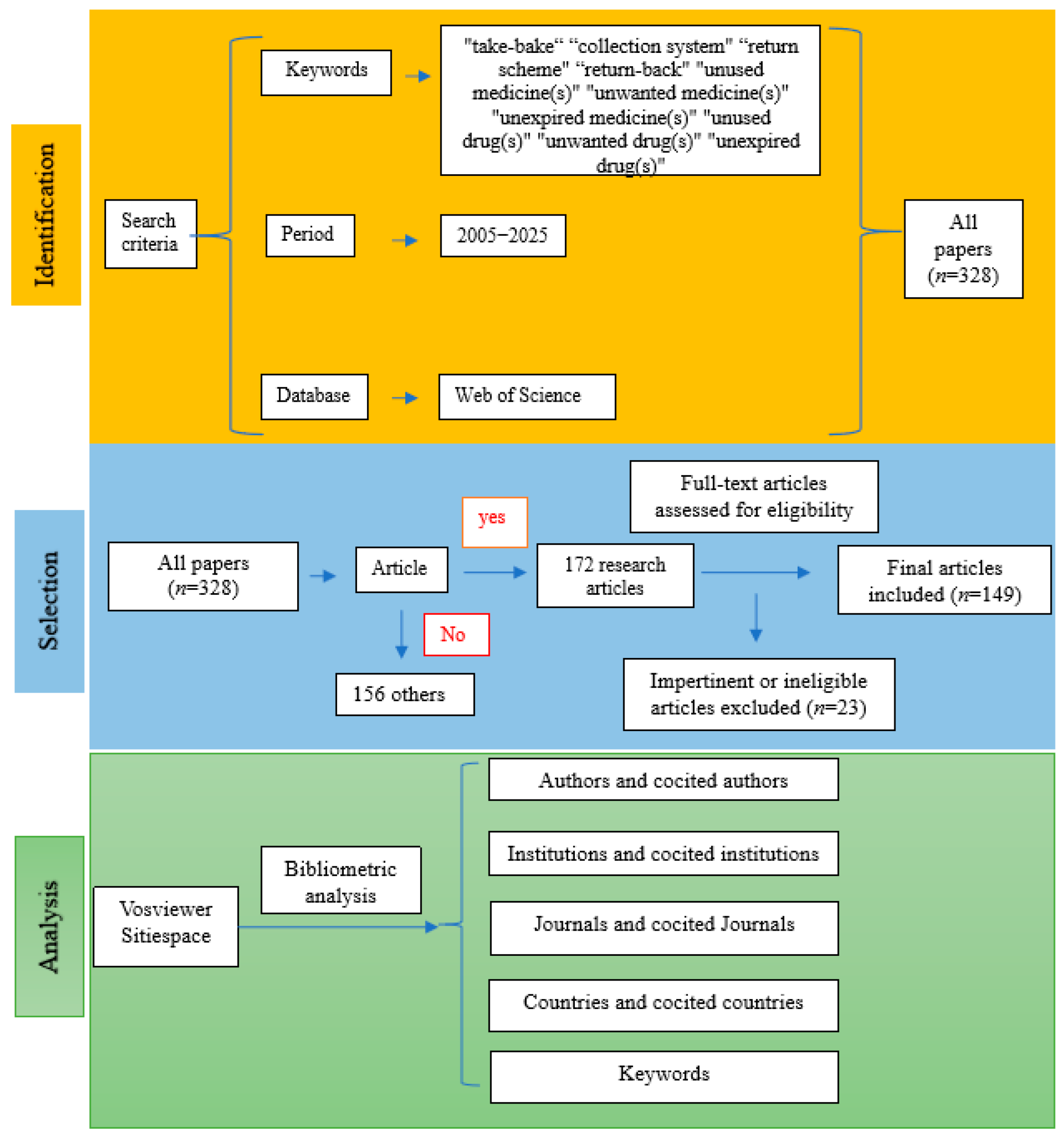
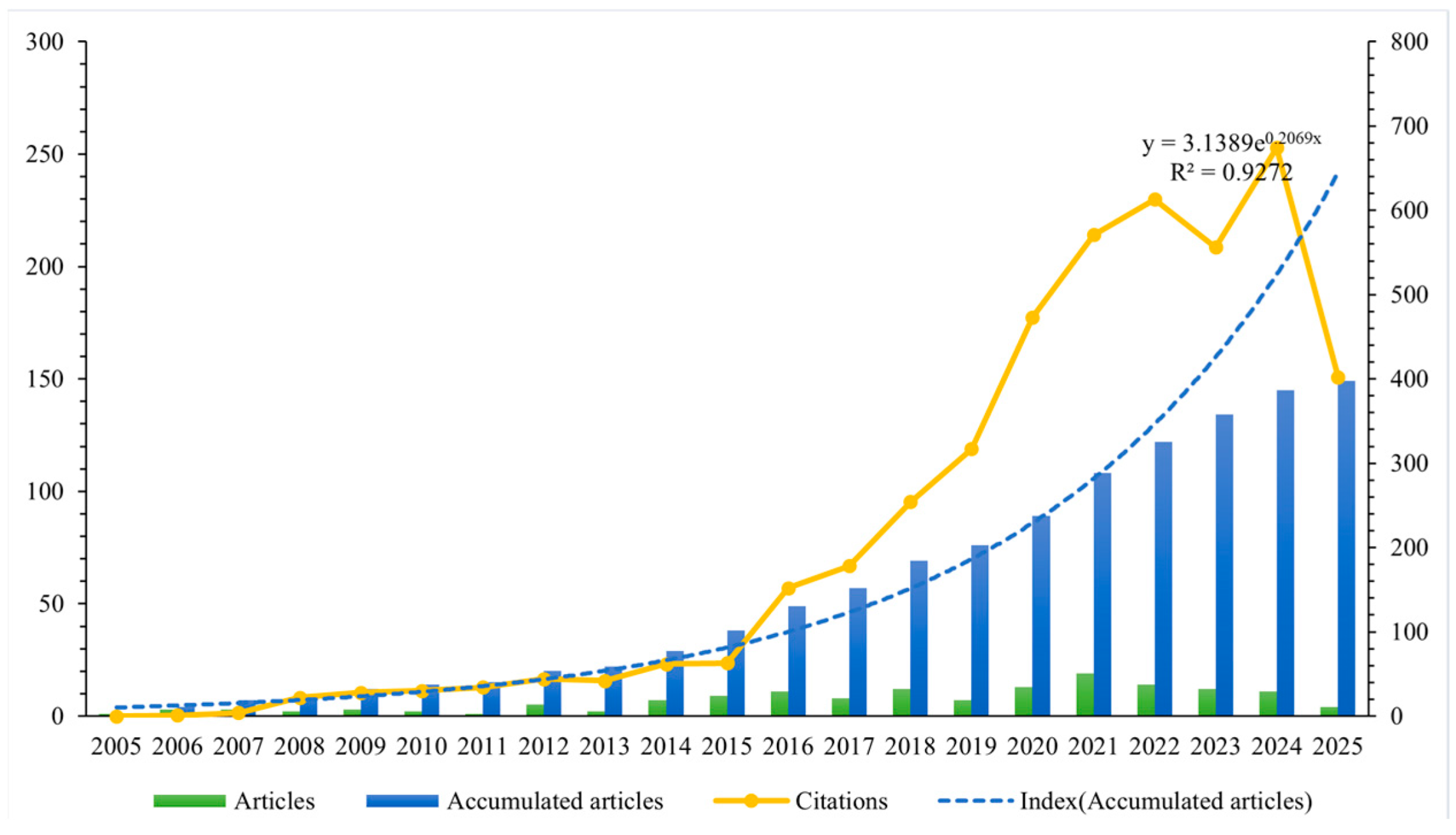
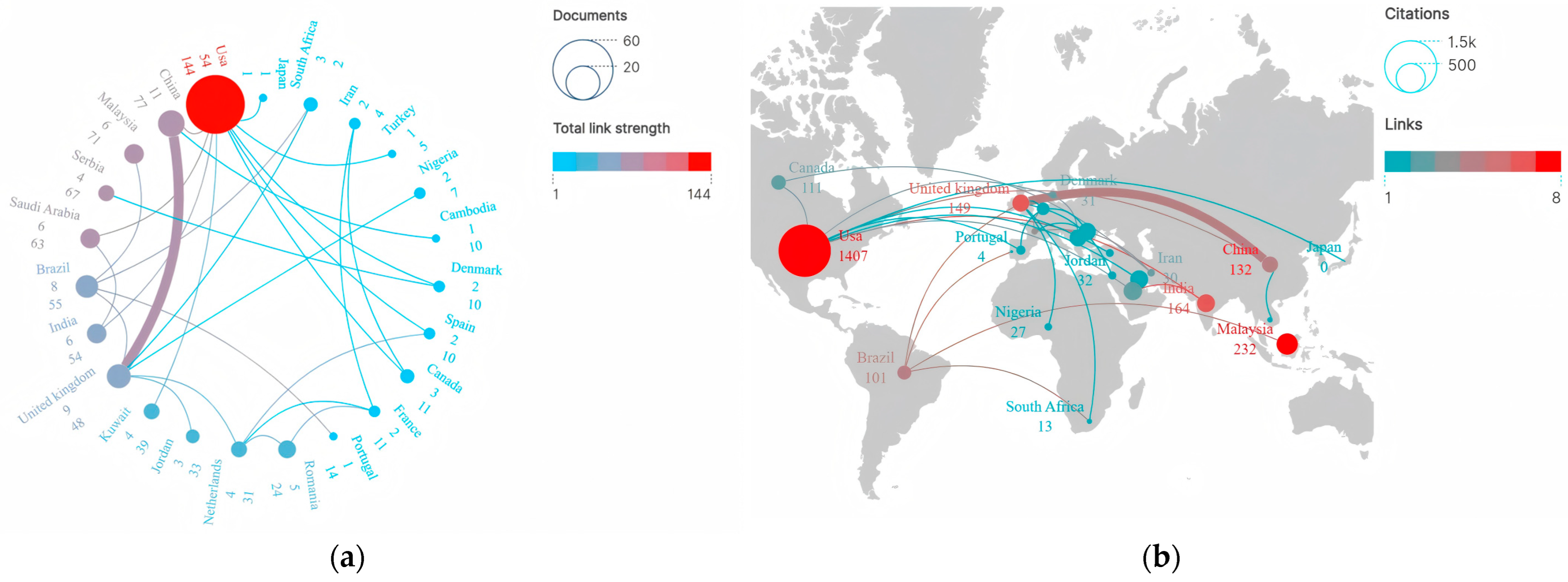
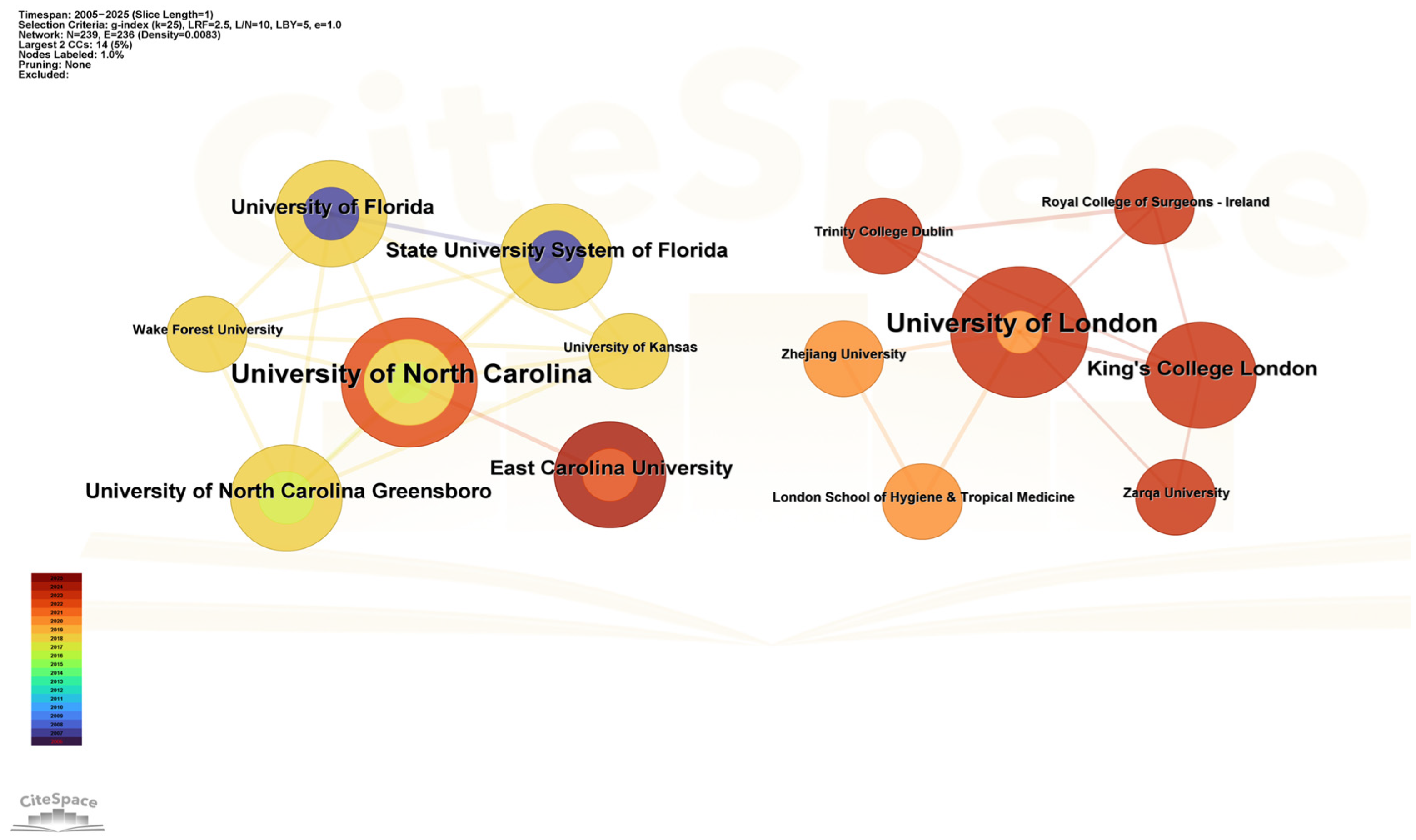
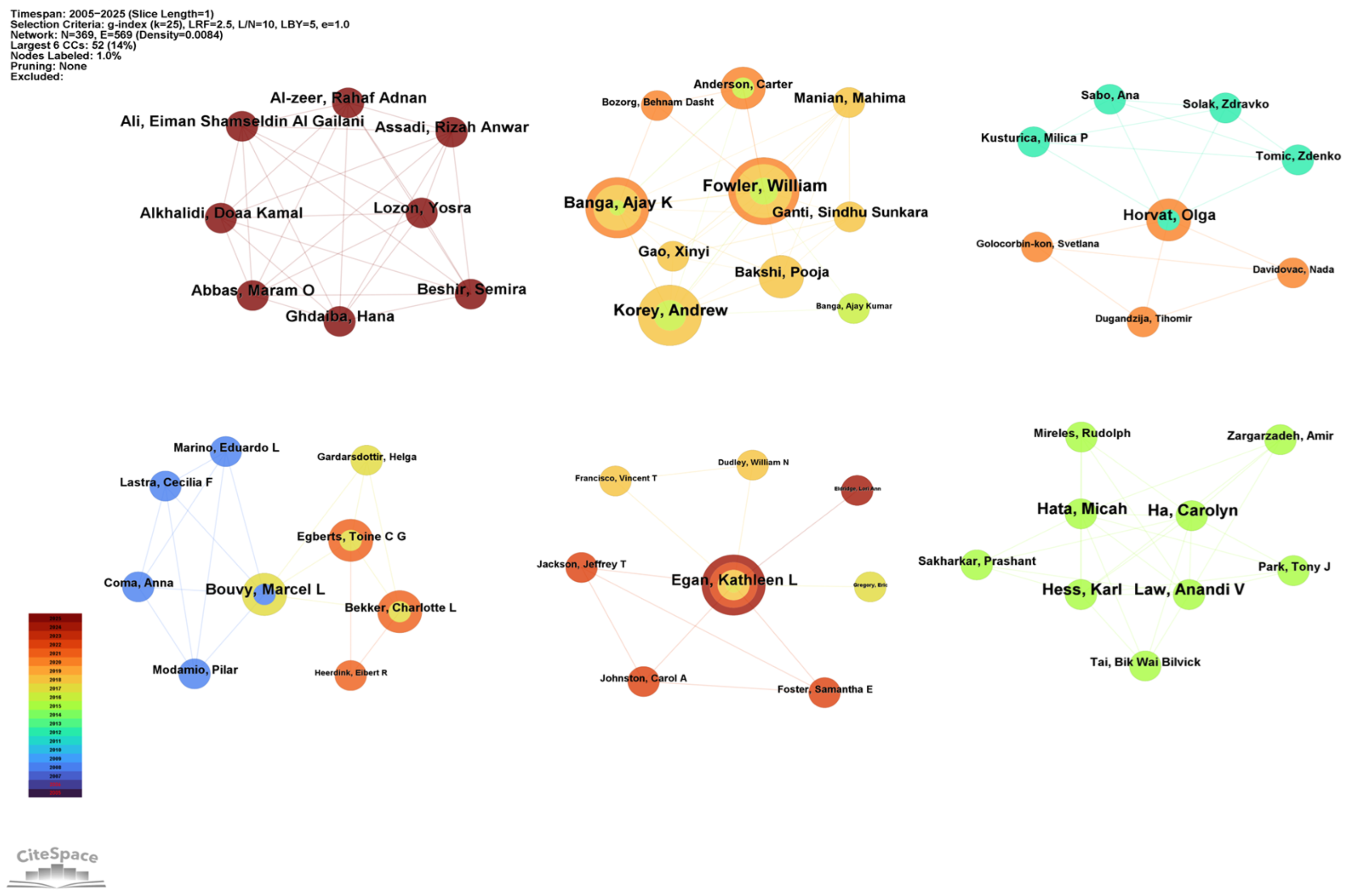

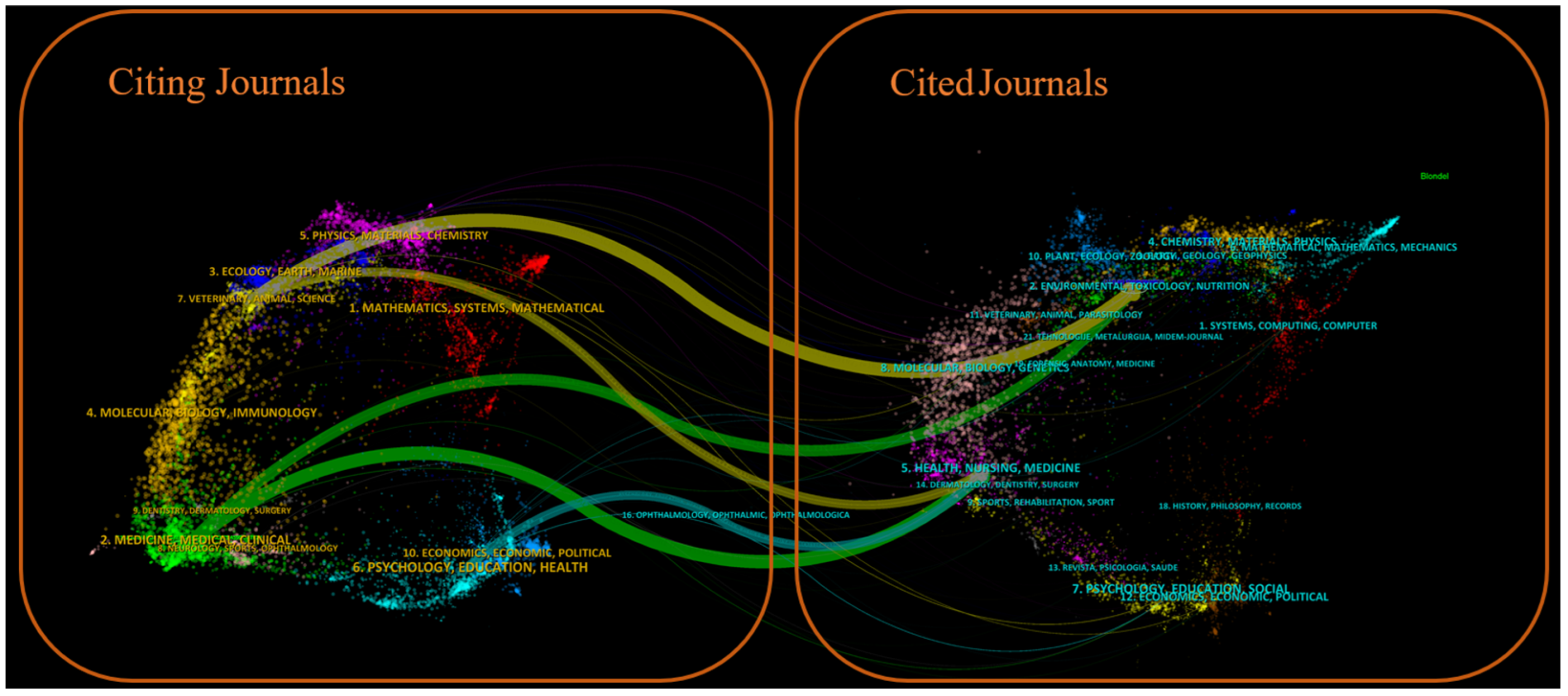
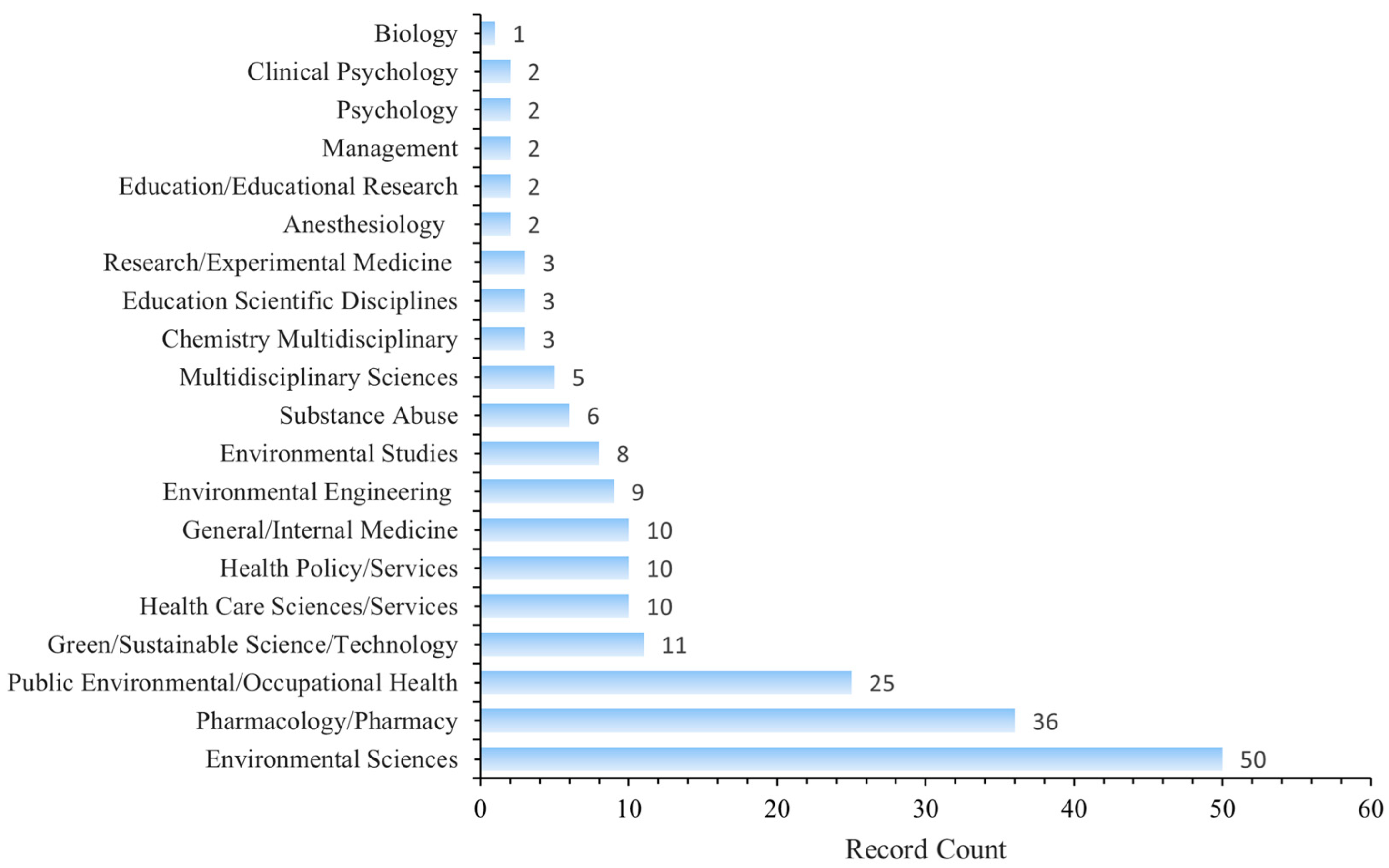
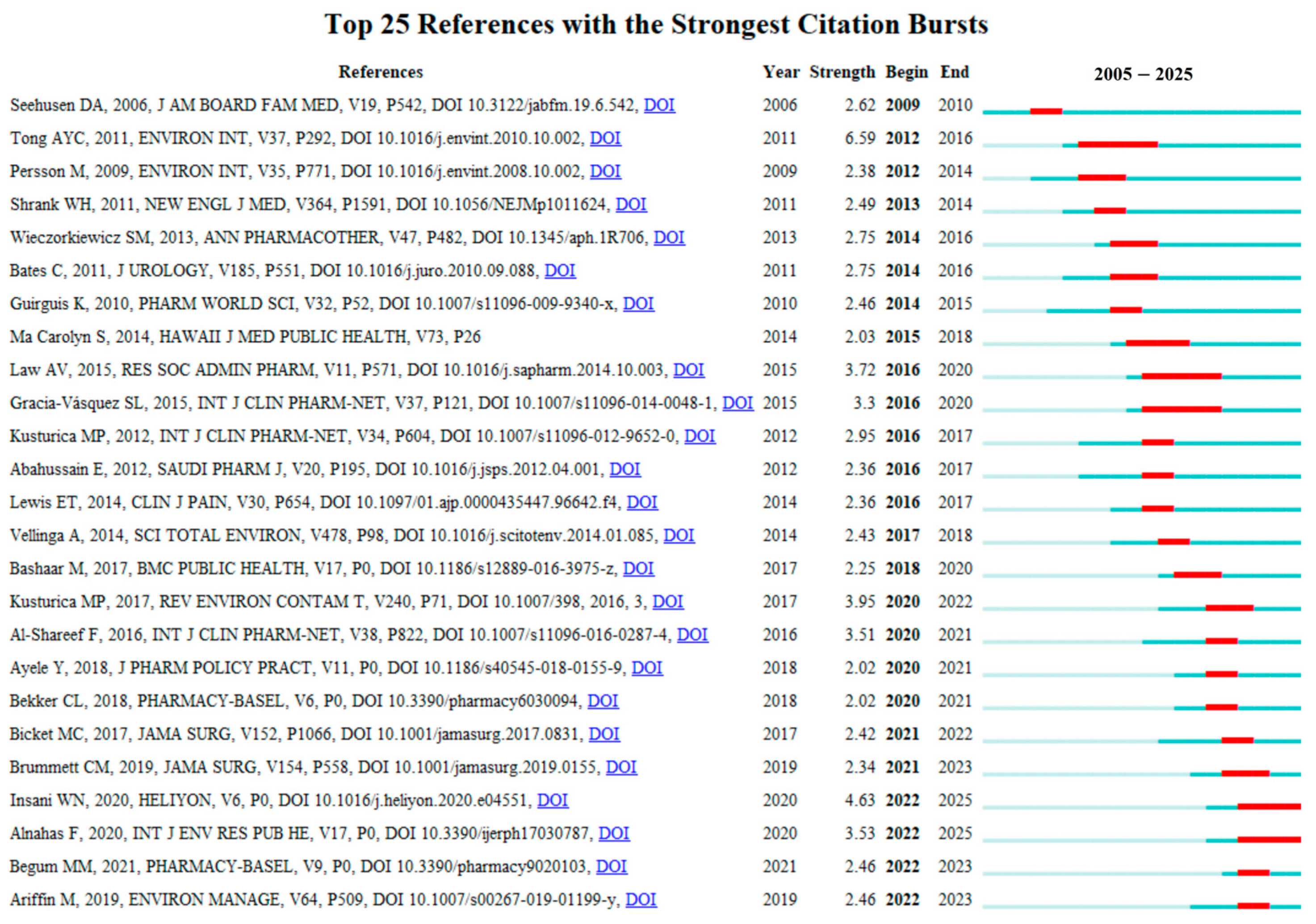
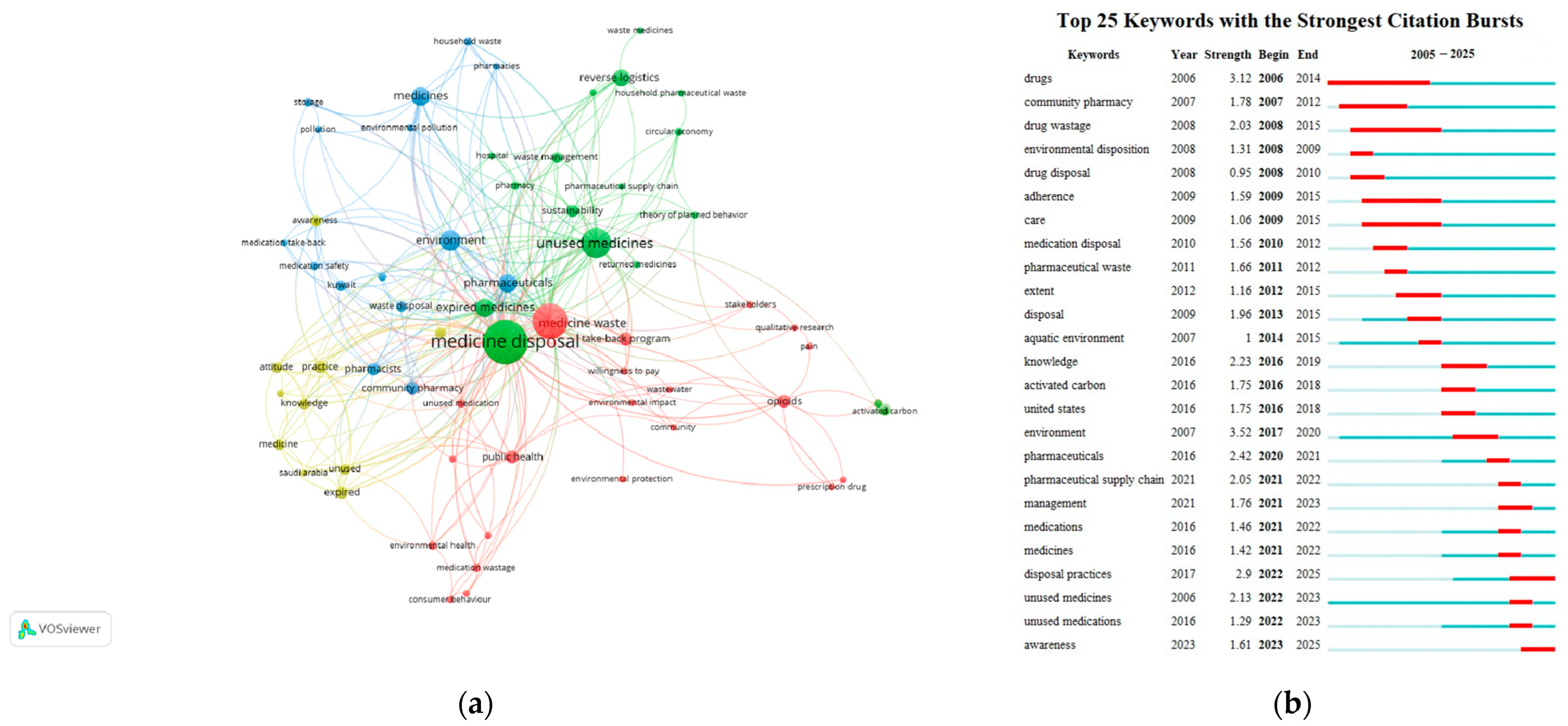
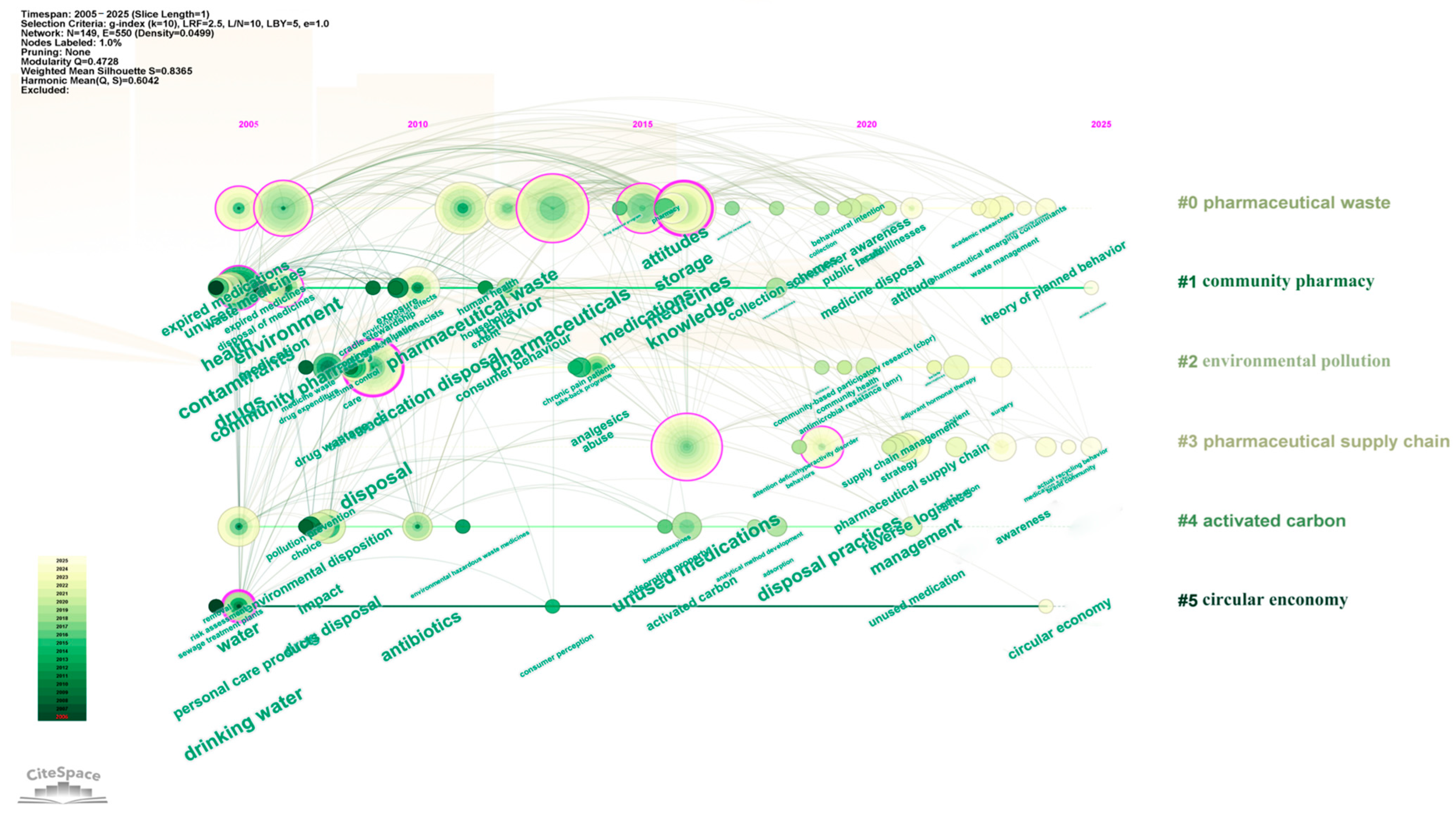
| Rank | Country | Publication Count | % of the Included Articles | Average per Item | H-Index | Citations | Total Link Strength * |
|---|---|---|---|---|---|---|---|
| 1 | US | 54 | 36.24 | 32.38 | 15 | 1407 | 144 |
| 2 | China | 11 | 7.38 | 10.64 | 7 | 132 | 77 |
| 3 | England | 9 | 6.04 | 17 | 6 | 179 | 48 |
| 4 | Brazil | 8 | 5.37 | 9.45 | 5 | 101 | 55 |
| 5 | India | 6 | 4.02 | 14.33 | 6 | 164 | 54 |
| 6 | Malaysia | 6 | 4.02 | 17.78 | 6 | 232 | 71 |
| 7 | Saudi Arabia | 6 | 4.02 | 3.78 | 4 | 179 | 63 |
| 8 | Netherlands | 5 | 3.36 | 32 | 4 | 146 | 21 |
| 9 | Romania | 5 | 3.36 | 30 | 4 | 149 | 24 |
| 10 | Kuwait | 4 | 2.68 | 28.2 | 4 | 161 | 39 |
| Rank | Institutions | Publication Count | % of the Included Articles | Citing Articles | Times Cited | Average per Item | H-Index |
|---|---|---|---|---|---|---|---|
| 1 | Mercer University | 5 | 3.36 | 40 | 49 | 9.8 | 5 |
| 2 | University of North Carolina | 4 | 2.68 | 122 | 141 | 35.25 | 4 |
| 3 | King Saud University | 4 | 2.68 | 65 | 75 | 18.75 | 3 |
| 4 | Radboud University | 3 | 2.01 | 157 | 181 | 60.33 | 3 |
| 5 | University of Novi Sad | 3 | 2.01 | 63 | 69 | 23 | 3 |
| 6 | Kuwait University | 3 | 2.01 | 146 | 147 | 49 | 2 |
| 7 | Universiti Sains Malaysia | 3 | 2.01 | 21 | 21 | 7 | 2 |
| 8 | University of California System | 3 | 2.01 | 125 | 137 | 45.67 | 3 |
| 9 | Wake Forest University | 3 | 2.01 | 141 | 142 | 47.33 | 2 |
| 10 | University of Novi Sad | 3 | 2.01 | 63 | 69 | 23 | 3 |
| Rank | Author | Publication Count | % of the Included Articles | Average per Item | H-Index | Citations | Total Link Strength * |
|---|---|---|---|---|---|---|---|
| 1 | Banga Ak | 5 | 3.36 | 21.33 | 5 | 30 | 13 |
| 2 | Fowler W | 5 | 3.36 | 0.67 | 1 | 39 | 15 |
| 3 | Korey A | 5 | 3.36 | 5.33 | 2 | 39 | 15 |
| 4 | Egan Kl | 4 | 2.68 | 5.33 | 2 | 76 | 7 |
| 5 | Horvat O | 3 | 2.01 | 49 | 2 | 132 | 8 |
| 6 | Kusturica MP | 3 | 2.01 | 37 | 4 | 60 | 6 |
| 7 | Bekker Cl | 3 | 2.01 | 49 | 2 | 91 | 5 |
| 8 | Egberts Tcg | 3 | 2.01 | 5.5 | 2 | 11 | 7 |
| 9 | Abahussain E | 2 | 1.34 | 1 | 1 | 50 | 0 |
| 10 | Abahussain EA | 2 | 1.34 | 37 | 2 | 102 | 2 |
| Rank | Citation Frequency | Average per Year | Title | Journal | Author |
|---|---|---|---|---|---|
| 1 | 182 | 16.55 | Beyond the medicine cabinet: An analysis of where and why medications accumulate | Environment International | Ruhoy IS [32] |
| 2 | 177 | 9.83 | Taking stock of medication wastage: Unused medications in US households | Research in Social and Administrative Pharmacy | Law AV [33] |
| 3 | 146 | 8.59 | Pharmaceuticals in wastewater: Behavior, preferences, and willingness to pay for a disposal program | Journal of Environmental Management | Kotchen M [34] |
| 4 | 138 | 15.33 | Disposal practices of unused and expired pharmaceuticals among the general public in Kabul | BMC Public Health | Bashaar M [35] |
| 5 | 127 | 7.47 | Household disposal of pharmaceuticals as a pathway for aquatic contamination in the United Kingdom. | Environmental Health Perspectives | Bound JP, Voulvoulis N [16] |
| 6 | 118 | 9.83 | Public practice regarding the disposal of unused medicines in Ireland | Science of the Total Environment | Vellinga A [36] |
| 7 | 98 | 8.17 | What Do Patients Do With Unused Opioid Medications? | Clinical Journal of Pain | Lewis ET [37] |
| 8 | 85 | 10.83 | Aspects Regarding the Pharmaceutical Waste Management in Romania | Sustainability | Bungau S [38] |
| 9 | 84 | 14 | Improper disposal practice of unused and expired pharmaceutical products in Indonesian households | Heliyon | Insani WN [39] |
| 10 | 82 | 4.1 | Practice and opinion towards the disposal of unused medication in Kuwait | Medical Principles and Practice | Abahussain EA [29] |
| Rank | Keywords | Occurrences | Total Link Strength * |
|---|---|---|---|
| 1 | medicine disposal | 43 | 122 |
| 2 | medicine waste | 29 | 68 |
| 3 | unused medicines | 22 | 64 |
| 4 | environment | 12 | 34 |
| 5 | pharmaceuticals | 10 | 35 |
| 6 | expired medicines | 10 | 30 |
| 7 | reverse logistics | 9 | 16 |
| 8 | public health | 6 | 16 |
| 9 | take-back program | 6 | 14 |
| 10 | community pharmacy | 6 | 13 |
Disclaimer/Publisher’s Note: The statements, opinions and data contained in all publications are solely those of the individual author(s) and contributor(s) and not of MDPI and/or the editor(s). MDPI and/or the editor(s) disclaim responsibility for any injury to people or property resulting from any ideas, methods, instructions or products referred to in the content. |
© 2025 by the authors. Licensee MDPI, Basel, Switzerland. This article is an open access article distributed under the terms and conditions of the Creative Commons Attribution (CC BY) license (https://creativecommons.org/licenses/by/4.0/).
Share and Cite
Wu, S.; Zhou, X.; Hu, X.; Wang, J. Bibliometric Analysis and Review of Global Academic Research on Drug Take-Back Programs. Healthcare 2025, 13, 2711. https://doi.org/10.3390/healthcare13212711
Wu S, Zhou X, Hu X, Wang J. Bibliometric Analysis and Review of Global Academic Research on Drug Take-Back Programs. Healthcare. 2025; 13(21):2711. https://doi.org/10.3390/healthcare13212711
Chicago/Turabian StyleWu, Shuzhe, Xi Zhou, Xianmin Hu, and Jun Wang. 2025. "Bibliometric Analysis and Review of Global Academic Research on Drug Take-Back Programs" Healthcare 13, no. 21: 2711. https://doi.org/10.3390/healthcare13212711
APA StyleWu, S., Zhou, X., Hu, X., & Wang, J. (2025). Bibliometric Analysis and Review of Global Academic Research on Drug Take-Back Programs. Healthcare, 13(21), 2711. https://doi.org/10.3390/healthcare13212711






